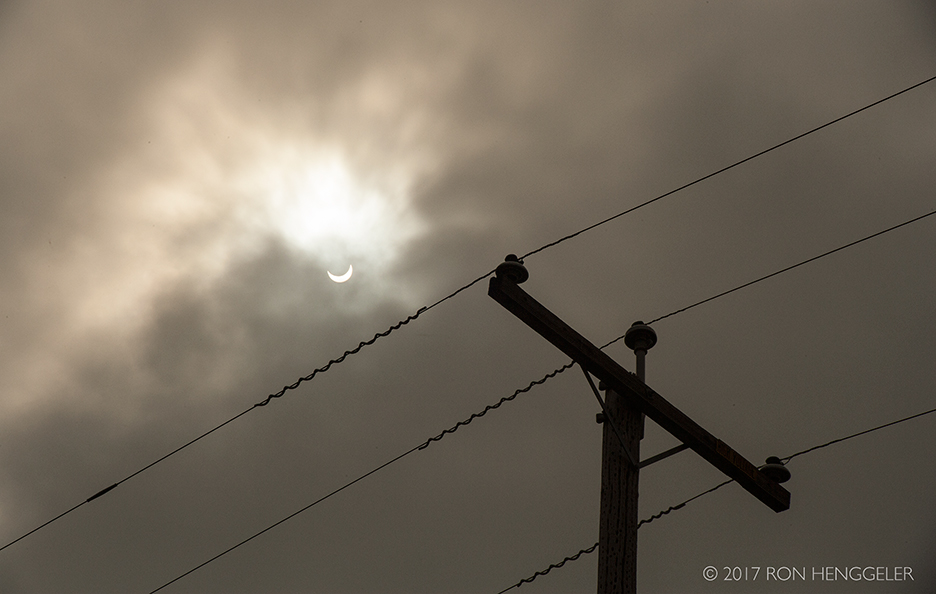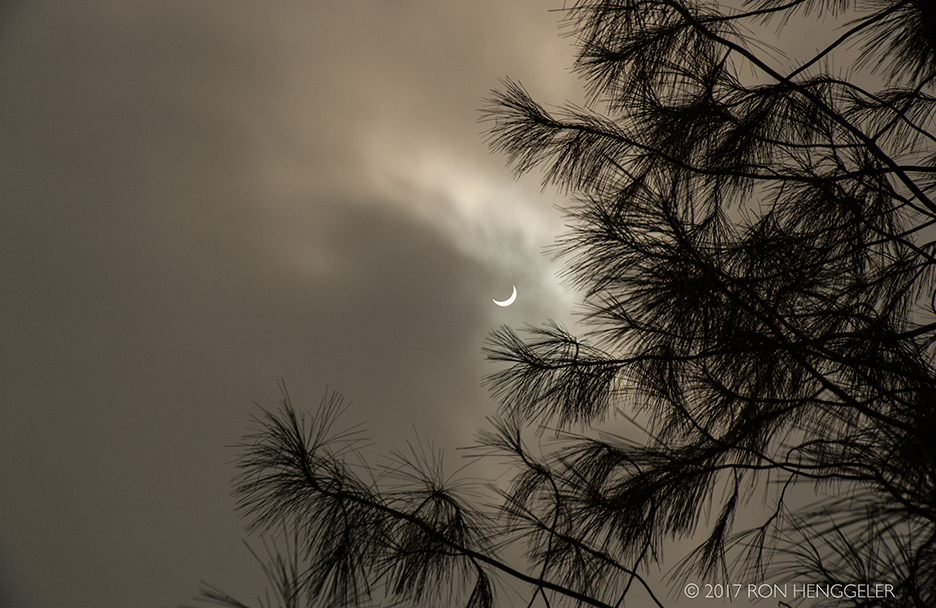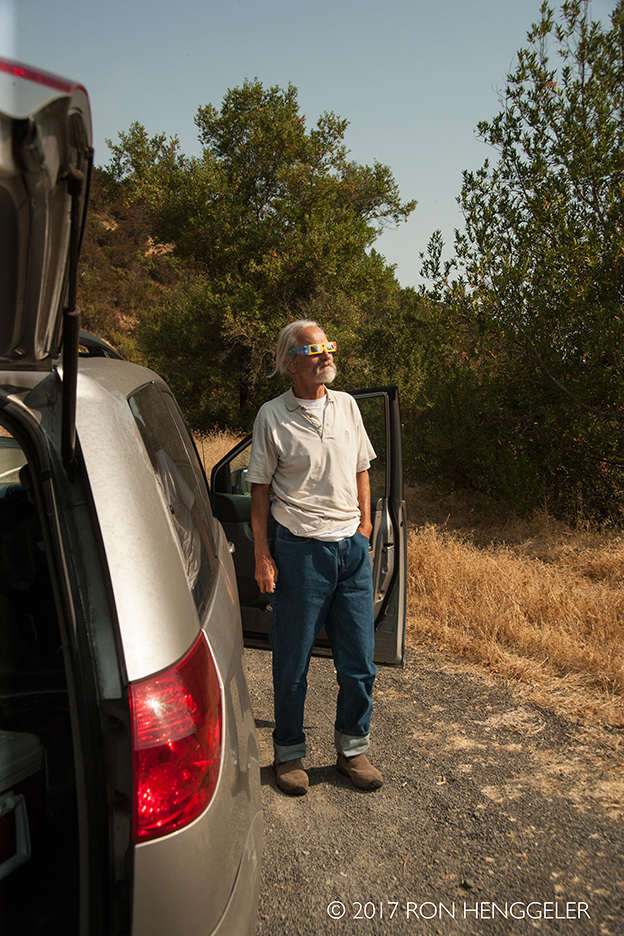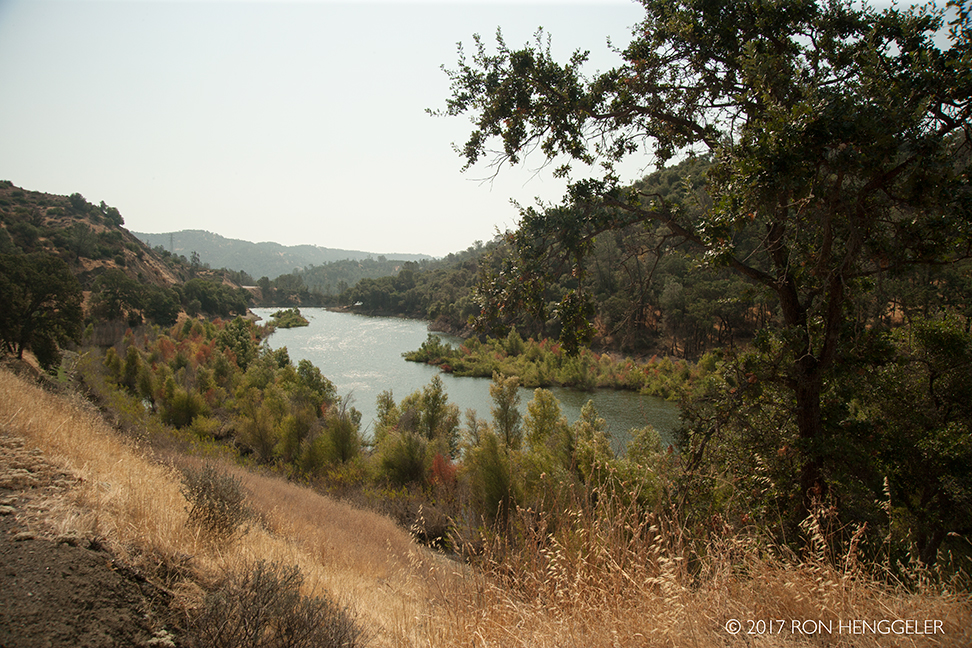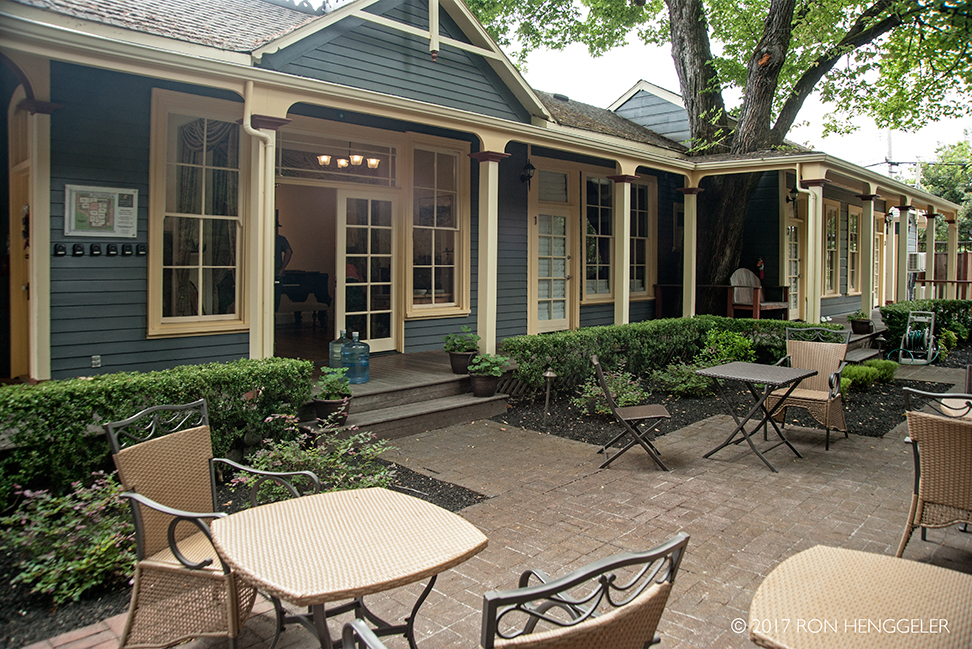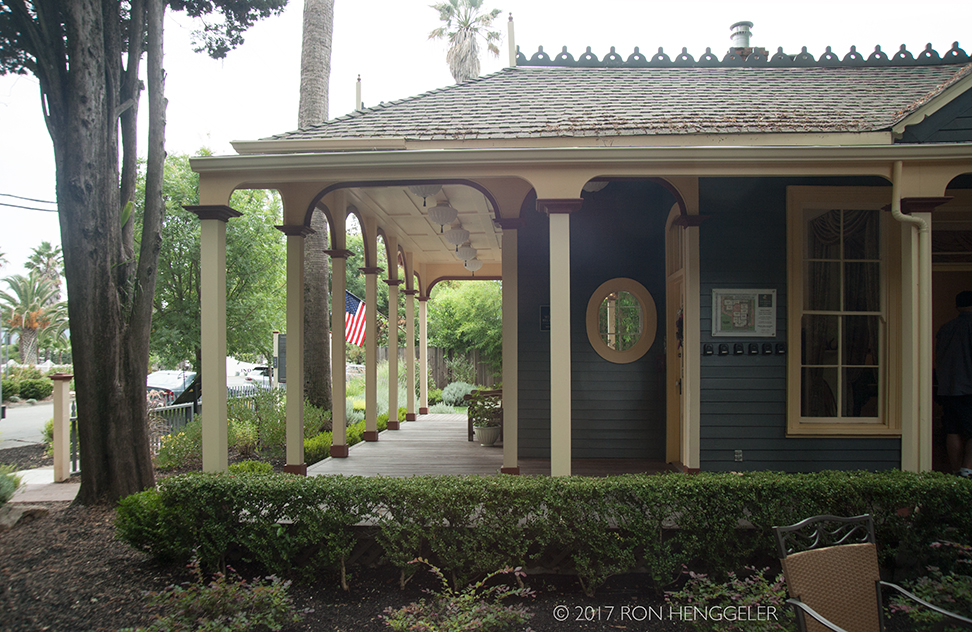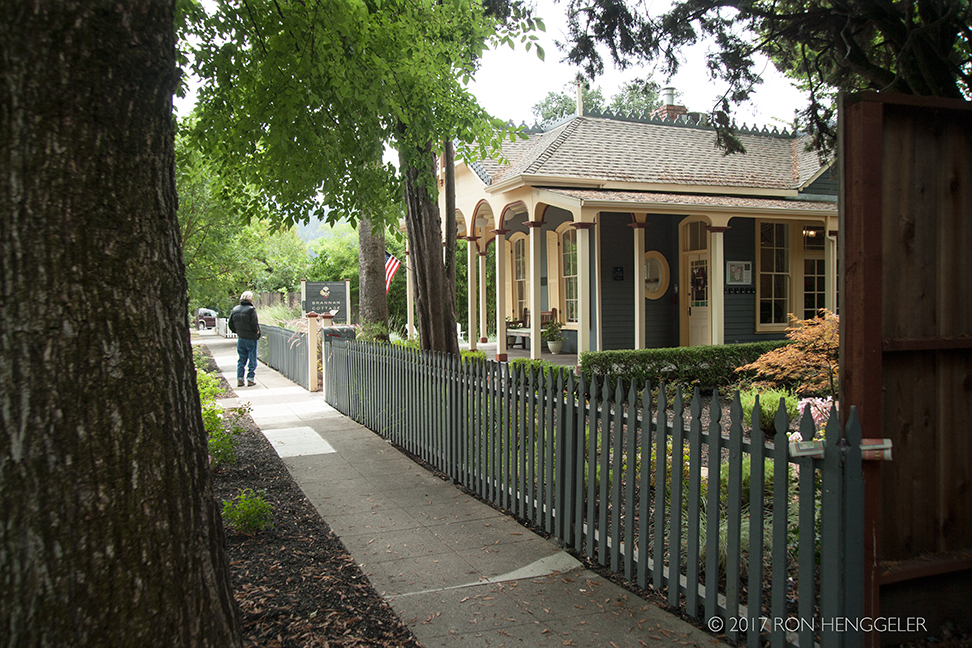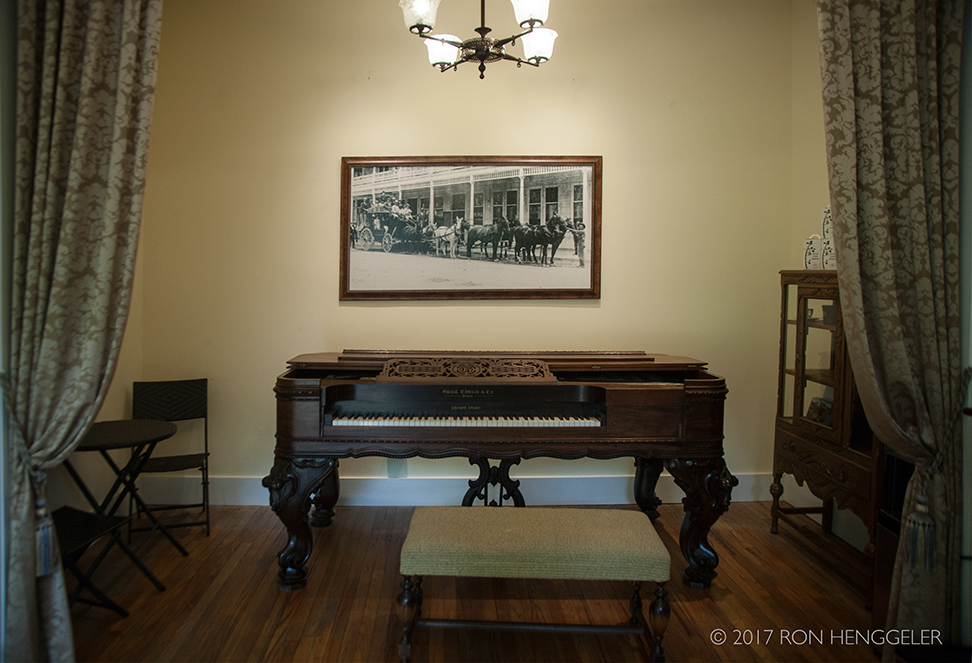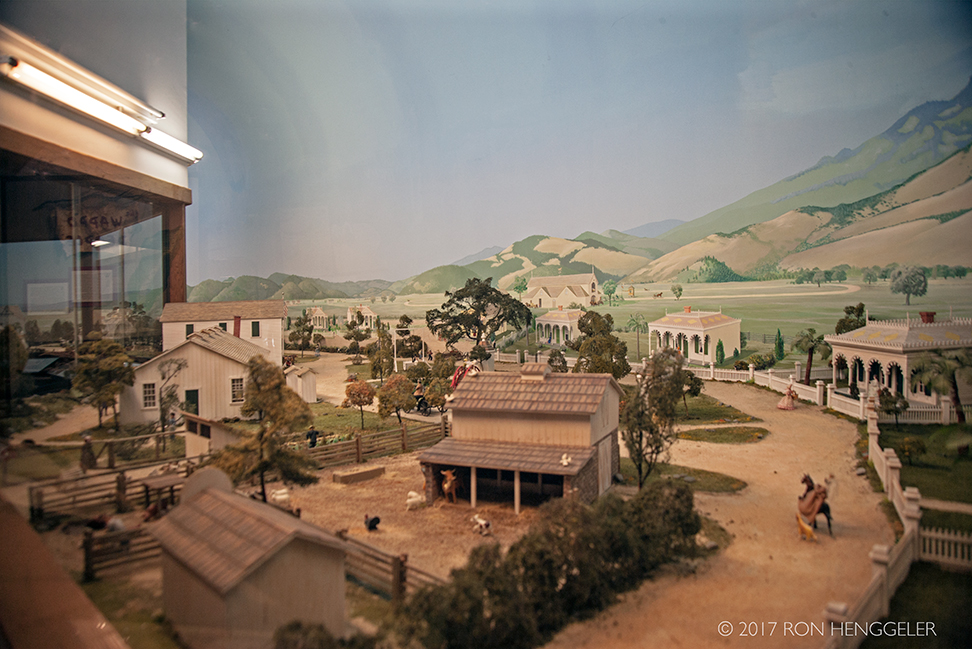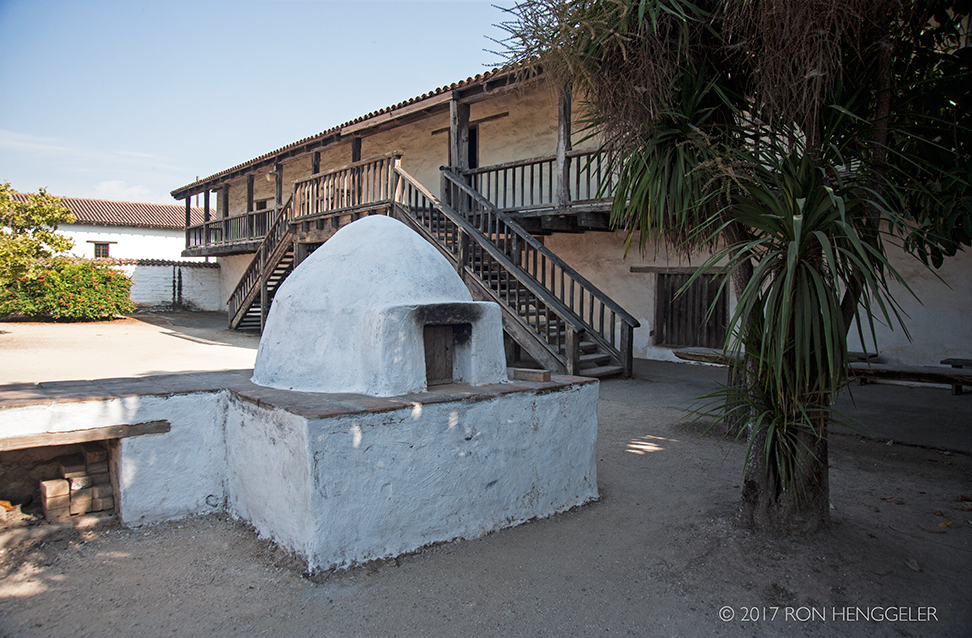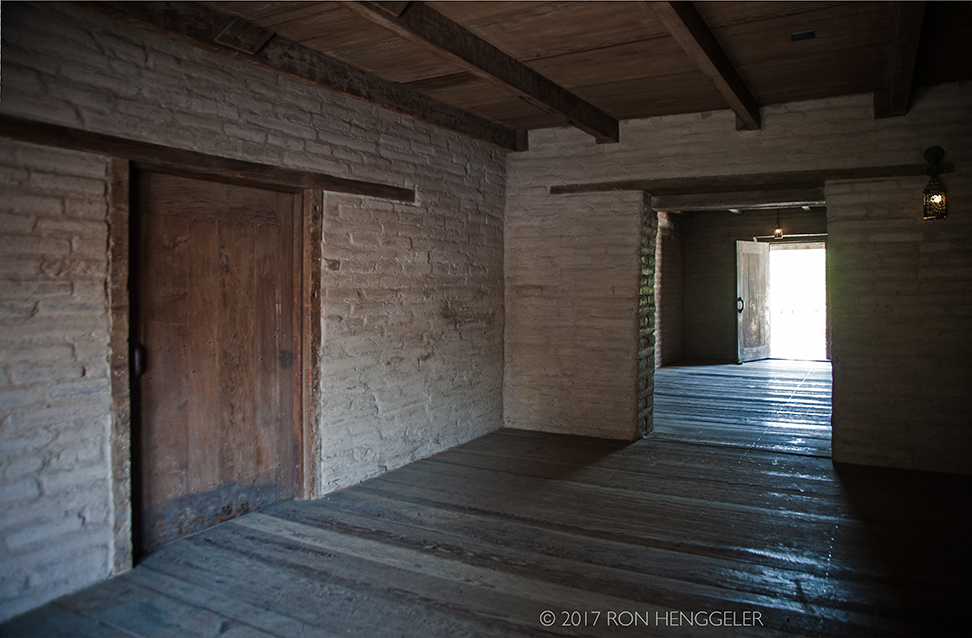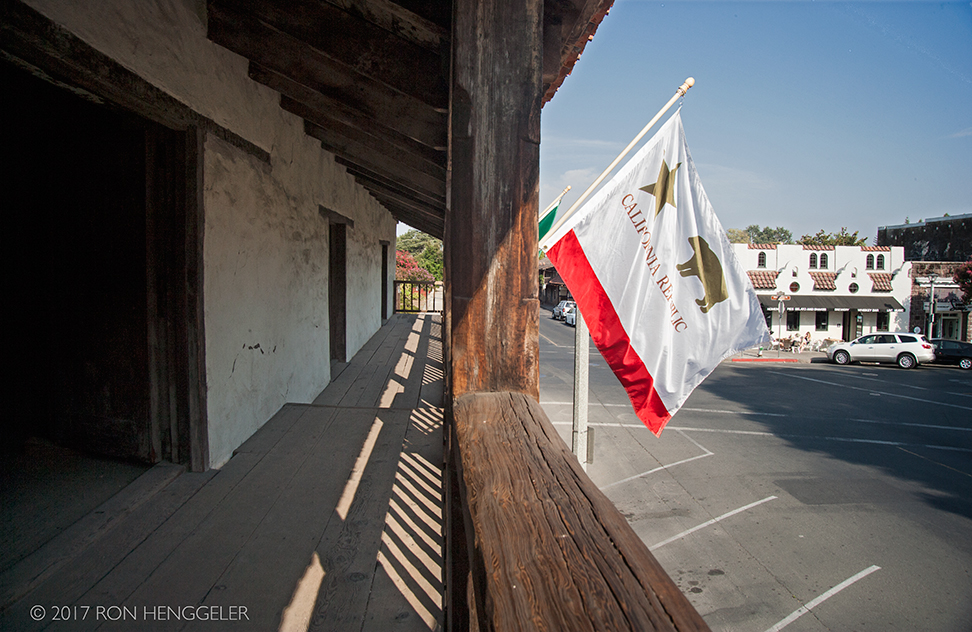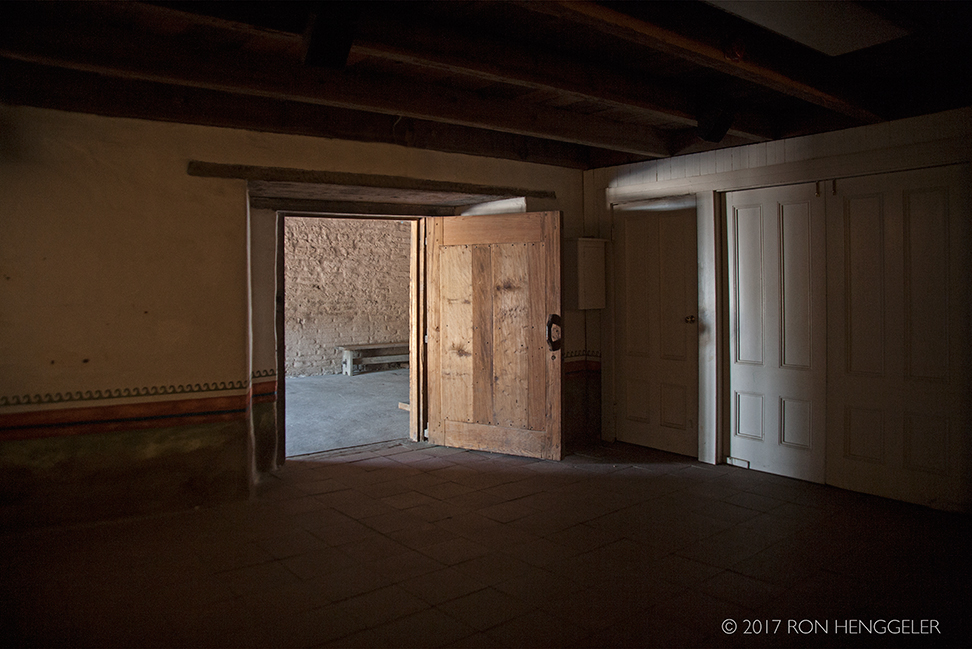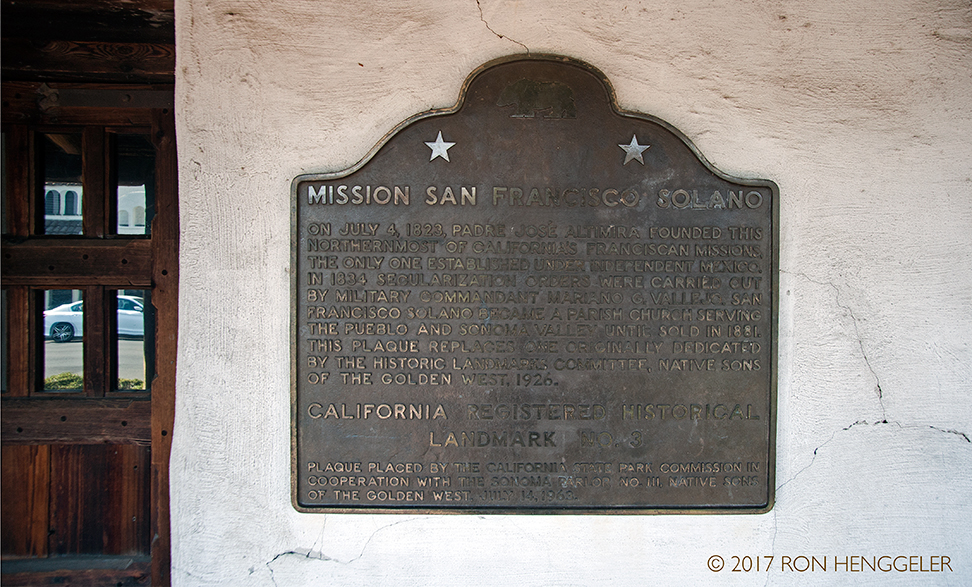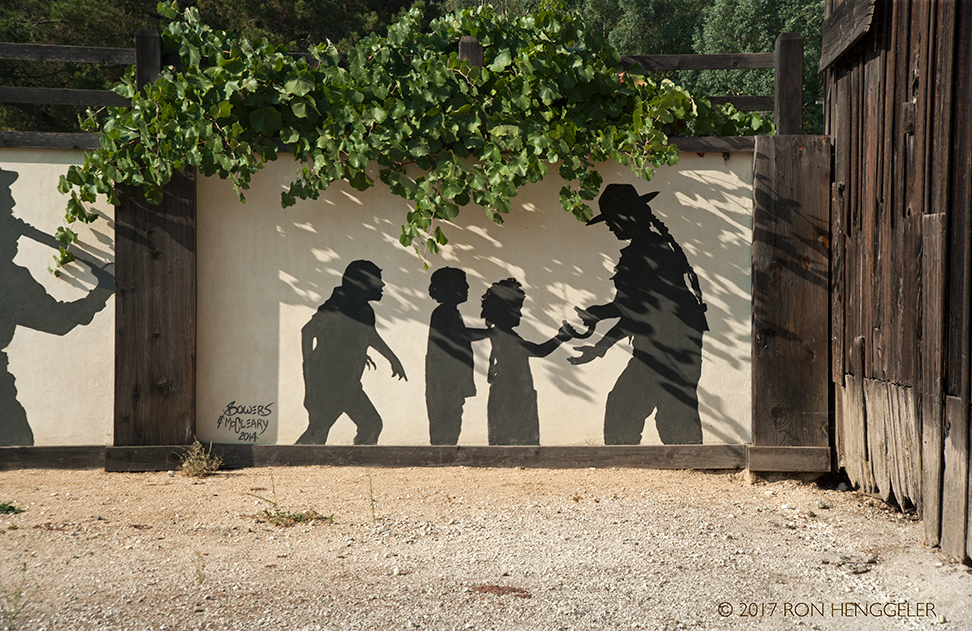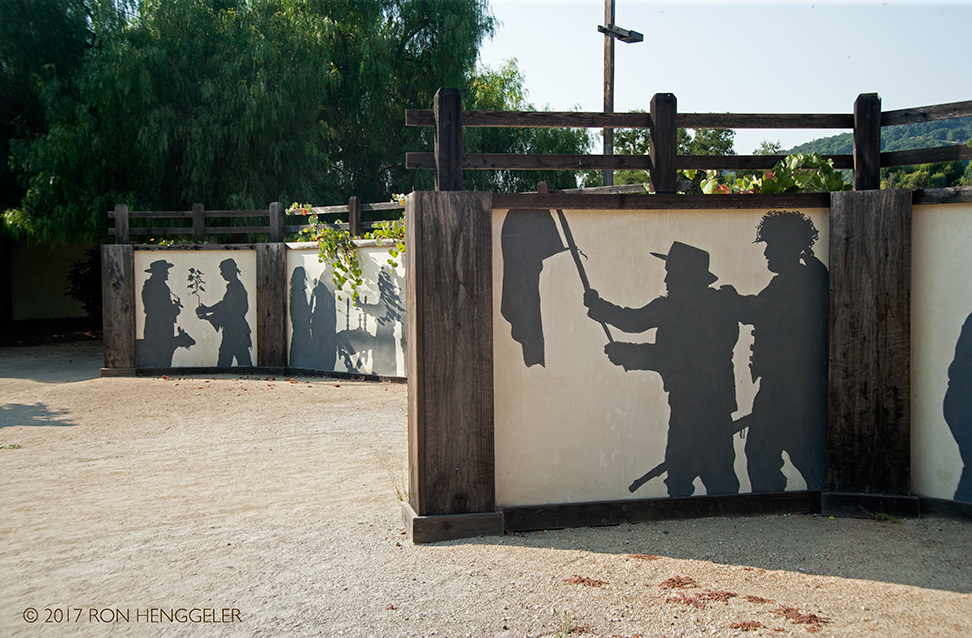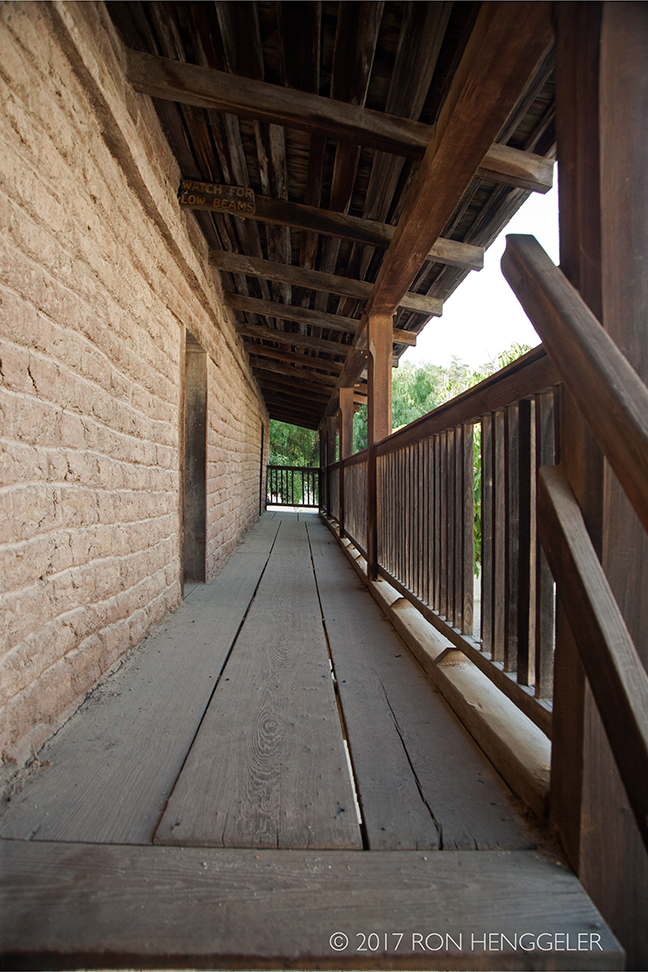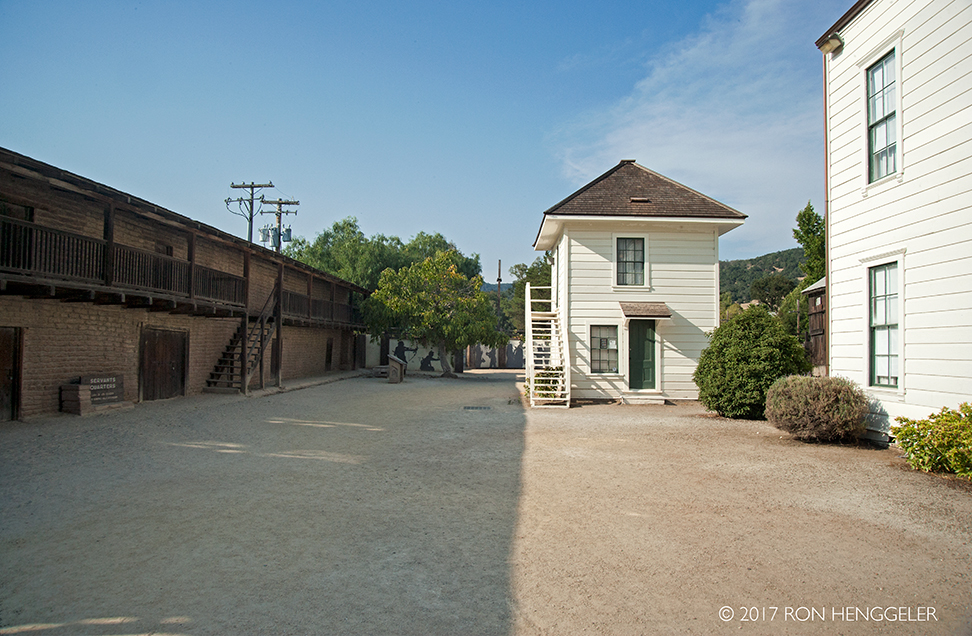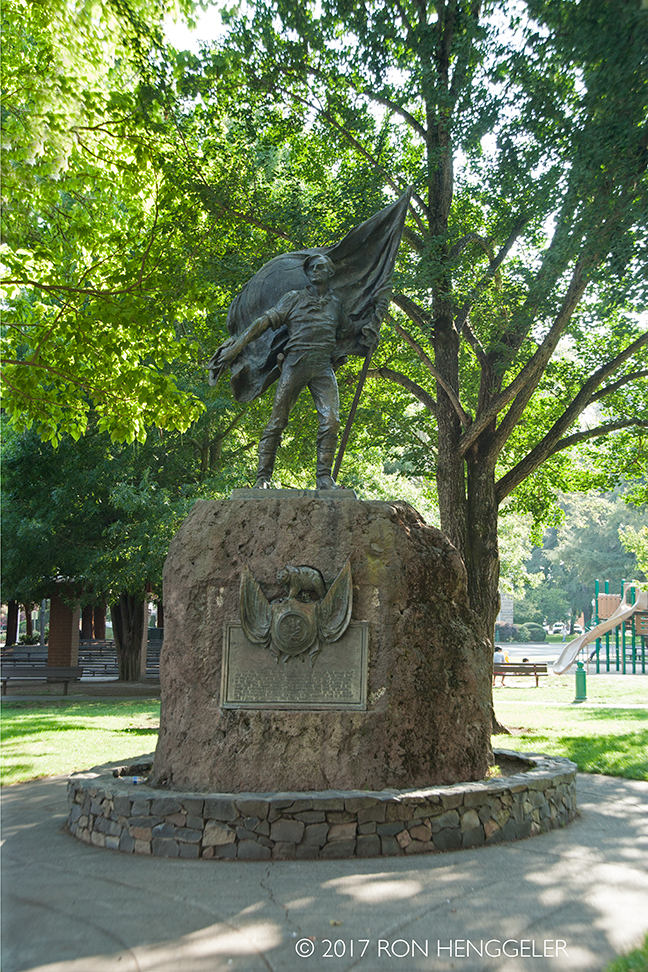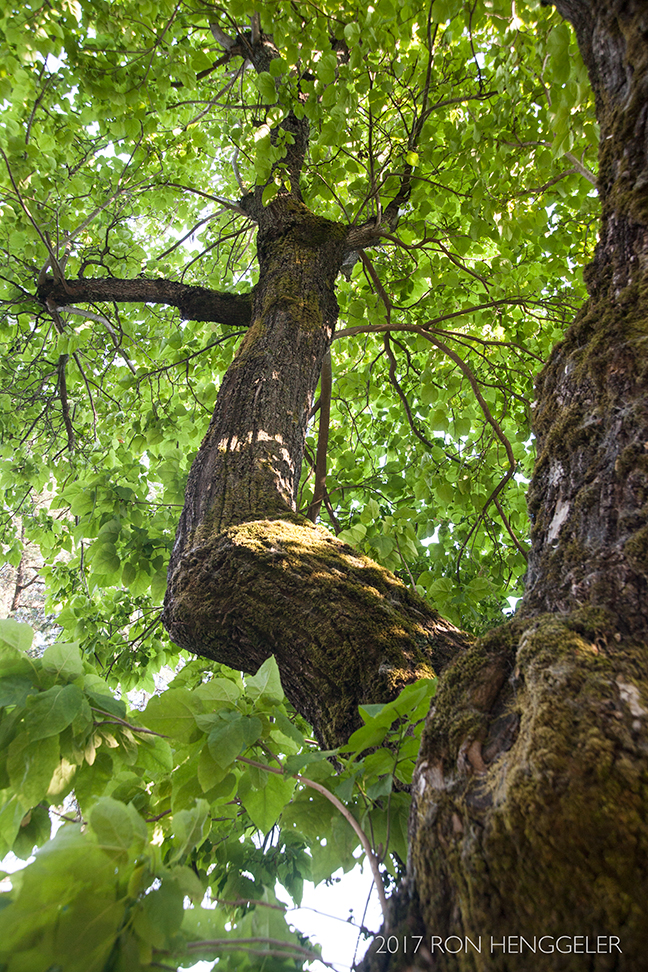RON HENGGELER |
August 21, 2017
The solar eclipse, Calistoga in Napa, the Sharpsteen Museum in Calistoga, and the Bear Flag Revolt in historic Sonoma
The solar eclipse on August 21th as seen from the Silverado Trail in Napa County, California.9:11am |
The solar eclipse on August 21th as seen from the Silverado Trail in Napa County, California. 9:18am |
The solar eclipse on August 21th as seen from near Lake Berryessa in Napa County,California.9:47am |
The solar eclipse on August 21th as seen from near Lake Berryessa in Napa County, California.9:56am |
The solar eclipse on August 21th as seen from Lake Berryessa in Napa County, California. |
The solar eclipse on August 21th as seen from Lake Berryessa in Napa County, California. |
9:58am |
The solar eclipse at 10:02am on August 21th as seen from near Lake Berryessa in Napa County, California. |
The solar eclipse at 10:04am on August 21th. |
The solar eclipse as seen from near Lake Berryessa in Napa County, California. |
|
The solar eclipse at 10:05am on August 21th as seen from near Lake Berryessa in Napa County, California. |
David watching the solar eclipse on August 21th near Lake Berryessa in Napa County, California.10:15am |
|
|
|
10:19am |
|
|
A view of a newly planted vineyard from near where we were watching the eclipse. |
A painted rock on the opposite side of the road from where we watched the solar eclipse on August 21th. |
|
The view to our left from where we watched the solar eclipse on the side of the road.10:23am on August 21th, 2017.Lake Berryessa in Napa County, California. |
A dead red-headed woodpecker on the pavement, hit by a car, near where we watched the solar eclipse on the side of the road.R.I.P. |
10:39am |
A view of Lake Berryessa in Napa County, California. |
Lake Berryessa in Napa County, California. |
The road through wine country, from Lake Berryessa on the way to Calistoga. |
|
Truck and dog sculpture at the Calistoga Mineral Water Company, on the Silverado Trail in Calistoga, Napa Valley. |
|
Brannan Cottage Inn in CalistogaAn artful blend of history, modern luxury and warm hospitality. The only 1862 hot springs resort cottage built by Calistoga founder Samuel Brannan still on its original site, this National Register of Historic Places icon has been restored and reimagined for a fresh twist on Victorian style. |
Brannan Cottage InnSam Brannan, California’s First MillionaireSamuel Brannan was to Calistoga what Nathan Coombs was to Napa.Brannan led a large group of Mormons to Yerba Buena (soon to be renamed San Francisco) in 1846. Brannan published a newspaper in San Francisco for a few years, then established a general store near Sutter’s Fort. He is credited for popularizing the Gold Rush, and his claims made him wealthy as he sold goods to the influx of miners with C.C. Smith & Company, his co-owned general store at Sutter’s Fort. In the earliest days of the Gold Rush, his was the only store between Gold Country and San Francisco. This also got him into trouble with the Mormon Church. They accused him of diverting tithe money to his business, which he refuted by supposedly saying “I’ll give the Lord his money when I get a receipt signed by the Lord.”From the Napa Historical Society |
In 1859 Sam Brannan bought a square mile of land in the far north of the Napa Valley containing hot springs. As the legend goes, during a particularly drunken evening, Brannan meant to say he would turn California into the famous Saratoga Springs, New York, but accidentally said he would make it the “Calistoga of Sarafornia,” and thus Calistoga gained its name. Brannan interested himself in a large variety of entrepreneurial endeavors. He showcased a silk worm farm, operated a brewery that was said to employ a member of the infamous Donner Party, and capitalized on the land’s natural resources. He didn’t stop there. Brannan was a key backer to the controversial railroad extension to Calistoga, and eventually the upper valley was connected by both road and rail. By the time Calistoga was incorporated in 1885, Brannan had long since relocated to San Diego County. California’s first millionaire was nearly broke after losing most of his personal fortune (tied up in real estate) to a bitter divorce. He died in 1889 debt free but without enough left to cover his funeral costs.From the Napa Historical Society |
The trunk of a 300 year old Siberian Elm tree that was already an old spirit when Sam Brannan built the cottage next to it. |
The crown of the 300 year old Siberian Elm tree alongside the Brannan Cottage Inn. |
Quaint, charming and filled with history, Brannan Cottage Inn portrays the sweet small-town culture of Calistoga. A 150-year-old attendant palm tree greets you at the entrance before walking up the steps where generations before have stood, including Brannan himself. The wrap-around porch and encompassing arches welcome you into an era of genuine hospitality. Friendly staff are at your service and the sitting room makes you feel like this is your home from another time, complete with maps of the original Calistoga, portraits of the Brannan family and an antique piano.From A Moment in History: Samuel Brannan and His Namesake Inn by Elise Moore
|
Another Brannan resort cottage that was relocated and is now part of the Sharpsteen Museum in Calistoga. This cottage was moved from its original Calistoga Hot Springs Resort location to the museum property in the 1970s. At that time, it was attached to the museum building and rehabilitated into an exhibit space. The Brannan cottage filled with period furniture. |
Even though the Sharpsteen Museum in Calistoga, California is small, it certainly packs a mighty punch of history. If you find yourself passing through it's worth stopping for a visit. Ben Sharpsteen was an Oscar-winning animator and producer as well as a director for Walt Disney Studios. You'll be able to see many of the memorabilia from his projects with Disney on display. After Sharpsteen and his wife, Bernice, finished building the museum in 1978, they donated it to the City of Calistoga.From Roadtrippers.com |
|
The Sharpsteen Museum in CalistogaBen Sharpsteen, a veteran Disney animator, turned his gift for storytelling into a museum devoted to his love of Calistoga. In 1929, Ben received a letter from Walt Disney, who was pioneering animated films with sound, asking to meet him in Hollywood. Ben was impressed by what Disney was doing, and he began working for Walt as an animator. As time went on, Ben took on more of a supervisory and directorial role at the studio. He worked on more than 50 films for Disney as either an animator, director, or producer, and in all his work won 11 Oscars. After working for Disney for 30 years, Ben retired in 1959 and moved with his wife, Bernice, to their family property in Calistoga.From Atlas Obscura/Sharpsteen Museum |
The museum is packed with displays, artifacts, and dioramas that illustrate the history of Calistoga. One of the core exhibits is a 30-foot-long diorama depicting Sam Brannan’s Calistoga Hot Springs resort. Brannan was an entrepreneur who had numerous business interests in San Francisco. He opened the resort in 1862 and subsequently established a railroad line to Calistoga which brought in visitors from San Francisco and other cities, and these were major factors in the development of the area. Attached to the museum building is the last surviving cottage from the resort, which now houses displays of period fashion and furniture. Also on display at the museum is an original stagecoach which once ferried visitors to and from Calistoga before the establishment of the railroad line.From Atlas Obscura/Sharpsteen Museum |
This 30-ft. diorama of the original Hot Springs Resort is one of the main attractions in the museum. Taking nearly three years to complete, this painted background extends the diorama out to the horizon, with the Calistoga depot and Mt. St. Helena beckoning from right out of the wall. The Calistoga Hot Springs Resort was a thriving resort in 1860s. Inspired by the Saratoga Springs in New York, this was considered “The Saratoga of the Pacific.For more information, check out the History of Calistoga.
|
|
At the Sharpsteen Museum, a detail of the 30-foot-long diorama depicting Sam Brannan’s Calistoga Hot Springs resort. |
At the Sharpsteen Museum, a detail of the 30-foot-long diorama depicting Sam Brannan’s Calistoga Hot Springs resort. |
|
Also on display at the museum is an original stagecoach which once ferried visitors to and from Calistoga before the establishment of the railroad line. Stagecoaches were used to carry passengers and goods pulled by horses or mules. They first originated in the United States in the 1700s. This attraction at the Sharpsteen Museum is a stagecoach from the Calistoga and Clear Lake stage fleet. This served as a link between the railroad terminus in Calistoga and areas north of the city. The restored stagecoach is presented approaching the Calistoga Hotel. The stage was abandoned for motorized vehicles in 1912. |
The Sharpsteen Museum's permanent exhibits are designed to present the history of the upper Napa Valley from its pre-history to post World War I with an emphasis on people and changes brought by the period of U.S. emigration and development. In addition to its many historical exhibits, the Museum uses unique and extraordinarily extensive dioramas to depict Calistoga during its period as the elegant 1860s Hot Springs resort developed by pioneer, promoter, publisher, entrepreneur, and California's first millionaire, Sam Brannan. - Sharpsteen Museum |
Stagecoaches were used to carry passengers and goods pulled by horses or mules. They first originated in the United States in the 1700s.Sharpsteen Museum exhibits |
|
At the Sharpsteen Museum, a detail of the 30-foot-long diorama depicting Sam Brannan’s Calistoga Hot Springs resort. |
Ben SharpsteenIn addition to the permanent exhibits, the museum features two special exhibits each year. The museum also pays tribute to Ben and Bernice Sharpsteen themselves with a founders’ room, which displays artifacts from Bernice’s family history and from Ben’s animation career, including one of his Oscars (yes, it’s real). |
Walt Disney and Ben SharpsteenThe Sharpsteens gave the museum to the City of Calistoga in 1978. It is staffed entirely by dedicated volunteers. Ben passed away in 1980 and Bernice followed in 1982, but their legacy lives on in the Sharpsteen Museum. |
A bronze statue of Robert Louis Stevenon at the Sharpsteen.Robert Louis Stevenson Museum- St. Helena |
The Sharpsteen Museum in Calistoga |
|
|
The Sharpsteen Museum's permanent exhibits are designed to present the history of the upper Napa Valley from its pre-history to post World War I with an emphasis on people and changes brought by the period of U.S. emigration and development. In addition to its many historical exhibits, the Museum uses unique and extraordinarily extensive dioramas to depict Calistoga during its period as the elegant 1860s Hot Springs resort developed by pioneer, promoter, publisher, entrepreneur, and California's first millionaire, Sam Brannan. - Sharpsteen Museum |
|
This simulated barn exhibit is a recreation of the Fossville Barn that was located at a short-lived hostelry in Knight’s Valley, about five miles beyond Calistoga. This was the stopping point for stagecoaches traveling to the Geysers. The exhibit remarkably recreates that site and also provides a glimpse of rural living. The interior of the exhibit holds a variety of farming tools from that period.Sharpsteen Museum exhibits |
Interior of the Brannan Cottage, part of the Sharpsteen Museum in Calistoga. |
Interior of the Brannan Cottage, part of the Sharpsteen Museum in Calistoga. |
Interior of the Brannan Cottage, part of the Sharpsteen Museum in Calistoga. |
|
|
The Current Special ExhibitThe Cookie Jar Collection of Susan Wolleson-FreundHer collection now stands at over 300 pieces. There are currently over 100 on display at the Sharpsteen Museum. To learn more about Susan's collection of cookie jars, go to:Cookie Jars Are Everywhere |
|
This 30-ft. diorama of the original Hot Springs Resort is one of the main attractions in the museum. Taking nearly three years to complete, this painted background extends the diorama out to the horizon, with the Calistoga depot and Mt. St. Helena beckoning from right out of the wall. The Calistoga Hot Springs Resort was a thriving resort in 1860s. Inspired by the Saratoga Springs in New York, this was considered “The Saratoga of the Pacific.For more information, check out the History of Calistoga. |
|
This cottage was moved from its original Calistoga Hot Springs Resort location to the museum property in the 1970s. At that time, it was attached to the museum building and rehabilitated into an exhibit space. The Brannan cottage filled with period furniture. |
Bale Grist Mill State Historic ParkThe historic park is three miles north of St. Helena (3369 N St.) on Highway 29. |
The park is the site of a water-powered grist mill that was built in 1846. It was once the center of social activity as Napa Valley settlers gathered to have their corn and wheat ground into meal or flour. The owner of the mill was Dr. Edward Turner Bale. He received the property in a land grant from the Mexican government and lived near the site until his death in 1849. The mill remained in use until the early 1900s. |
The Bale Grist Mill and its 36-foot water wheel are protected as a state historic landmark and have been partially restored. A trail connects the historic park to Bothe-Napa Valley State Park. Additionally, the park includes the site of the first church in the Napa Valley as well as the Pioneer Cemetery. |
The gristmill and granary were built with local materials, Douglas firs and coast redwoods. Some timbers were cut to length with the bark left on, while others were roughed out with hand tools. The timbers were notched and held in place with wooden pegs as well as nails and screws.The foundation of the structure is native stone. The mill was powered by a waterwheel, with water diverted from Mill Creek nearby. A ditch carried the water from a millpond to a wooden flume, which brought the water to the top of the waterwheel.The first wheel did not provide enough power during dry summers and was replaced by a larger one, similar to the one at the mill today.Farmers brought grain to the mill where it was placed into the boot of an elevator to be mechanically transported upstairs where it was cleaned by various types of equipment. The slow turning of the old grind stones and the dampness of the mill's site gave the meal a special quality for making cornbread, yellowbread, shortening bread and spoon bread.As old timers put it, "When meal comes to you that way, like the heated underside of a settin' hen, it bakes bread that makes city bread taste like cardboard."From Bale Grist Mill State Historic Park |
|
Sonoma Plaza represents several important events in California's history. The Plaza is located in the center of Sonoma.
|
Sonoma State Historic ParkSonoma State Historic Park has a fee of $3 per person, 17 years and up. There is a $2 charge for those from 6 to17. The admission charge allows you to visit the Sonoma Mission, Sonoma Barracks, Toscano Hotel, General Vallejo Home and the Petaluma Adobe on the same day the ticket is purchased.Park hours are from 10:00 a.m. to 5 p.m. every day at all venues, except for the Petaluma Adobe which is closed on Monday. Closed holidays include Thanksgiving, Christmas and New Years Day. |
The Sonoma BarracksThe two-story, wide-balconied, adobe barracks facing Sonoma's central plaza was built to house Mexican army troops under the command of General Vallejo. These troops first arrived in Sonoma in 1834 when Vallejo, then the Commandant of the Presidio at San Francisco, was instructed to move his garrison to Sonoma. |
One whole room is dedicated to showing how the soldiers lived. Each soldier got a bed, storage trunk, a shelf, and area were lances and other weapons could be stored. There was also a common area for eating/drinking and entertainment such as cards. |
In the years after 1835, more than 100 military expeditions set out from Sonoma with the object of subduing the Wappos, Cainameros, or Satisyomis lndians who more than once rose up and attempted to throw off Mexican domination of the country around Sonoma. Many of these expeditions were led by Vallejo himself, but others were led by Vallejo's younger brother, Salvadore, or by Sem-Yeto, the tall, ruggedly handsome Chief of the Suisunes lndians whose christian name was Francisco Solano, and who came to be one of Vallejo's closest and most valuable allies.taken from The Sonoma Barracks |
Following the Bear Flag takeover of Sonoma on june 14, 1846, the barracks housed a number of Bear Flag followers until July 9, when the Stars and Stripes were first raised at Sonoma. Thereafter the barracks were used by various U.S. military forces starting with the 50 men who made up Company "B", California Battalion Mounted Riflemen commanded by Lt. Joseph Revere, an officer in the U.S. Navy.taken from The Sonoma Barracks |
In March 1847, these troops were replaced by Company "C" of Colonel Stevenson's New York Volunteer Regiment, and in May, 1849, a 37-man company of U.S. dragoons moved into the building and established Camp Sonoma. |
Throughout the next few years Sonoma continued to be an important army post, and some of the officers who were stationed there became close friends of General Vallejo and his family.In 1860 Vallejo remodelled the building to serve as a winery. In later years under other owners it was used as a store, law office, and private residence. Purchased by the State in 1958, and partially restored, the building is today listed as State Historical Landmark Number 316. |
|
From 1834 until 1846, Sonoma was the headquarters of the commandant of the Frontera del Norte - the Mexican provincial frontier of the north. Actual construction of the adobe barracks building probably took place in stages, but was more or less completed in 1840 and '41.taken from The Sonoma Barracks |
Outside in the the courtyard of the Sonoma Barracks one can see what would have been the work and training area. To your right is a wagon and a view of the Mission across the street. |
Opposite the wagon is the outdoor kitchen with the beehive oven featured. |
The gate into the courtyard of the Sonoma Barracks |
|
The Sonoma Barracks are directly across the street (West) from the Mission San Francisco Solano. Your admission price to the Mission includes the barracks or, if you purchase an admission at the barracks it will be good at the Mission. The displays in the barracks are mostly directed toward the life of the soldiers but also include some general post-mission era items. You can also watch a movie describing the history of the area. |
After the takeover of California the Barracks served as the headquarters of American detachments, but even these moved out by the 1850s. General Vallejo, now a State Senator living in the area at Lachryma Montis, remodeled the building as a winery. Later it was converted into a store, law offices, and a private residence. The State purchased the building in 1958 and by 1980 it had been restored to its original form. |
|
The original Bear Flag was made in the Sonoma Barracks on June 14 or 15, 1846. Other Bear Flags, four or more of them, were made between June 15 and July 9 for use at Bodega Bay and elsewhere. When the original Bear Flag was lowered at Sonoma July 9, it was given as a memento to one of the sons of Captain Montgomery of the U.S.S. Portsmouth then at San Francisco Bay. Montgomery took the flag to Washington, D.C. where it was placed in the archives of the Naval Department. In 1855, at the request of California’s Congressional delegation, the flag was returned to California for permanent display in the San Francisco headquarters of the Society of California Pioneers. The flag on display in the barracks is a copy made by the Pioneers before the original flag was destroyed in the San Francisco earthquake and fire of 1906. |
|
|
The balcony of the Sonoma Barracks overlooking the Sonoma Plaza. |
|
The first thing one sees when entering into the barracks is a well-preserved cannon from the era. |
David on the barrack balcony the overlooks the Sonoma Plaza |
On July 4, 1824, Mission San Francisco Solano de Sonoma, the last of the chain of 21 missions, was founded by Father Jose Altimira. It was also the only mission established during the Mexican period. While the original mission buildings were wooden structures, the present mission church, located at 114 East Spain Street, is adobe. |
The last and northernmost California mission, Mission San Francisco Solano in Sonoma was the only mission founded after Mexico's independence from Spain. It was also the only mission founded without the prior approval of the Church. |
detail of the Mission San Francisco Solano |
The site of Mission San Francisco Solano was selected and ceremoniously consecrated by Father Jose Altimira on July 4, 1823. It was named after Father San Francisco Solano, a 17th century missionary to Peru. This mission became the last and most northerly of the 21 California missions. The first building was a temporary wooden structure plastered inside and out with whitewashed mud.Construction began in October 1823 led by Father Altimira. The vineyards were flourishing. The coast Miwok Indians came back as soon as construction began. The Indians constructed a temporary wooden chapel in the palisade style tying logs together with leather ropes to form walls and covering with a thatch roof. On April 4, 1824, the chapel was dedicated and the first baptisms performed. Adobe buildings began to take shape. |
Several hundred Indian neophytes from Dolores followed the Franciscans to Sonoma, but the copious gifts from sister missions which usually arrived to start a new mission on its way failed to reach Sonoma. Help came from an unexpected source. The Russian fur traders proved to be friendly, sharing their supplies and donating Russian-designed bells.Mission San Francisco Solano de Sonoma, the last of the chain of 21 missions, was founded by Father Jose Altimira. It was also the only mission established during the Mexican period. While the original mission buildings were wooden structures, the present mission church, located at 114 East Spain Street, is adobe. |
Mission Solano is located across the street from the Sonoma military barracks, built in 1836 by General Vallejo. It is here where the first bear flag was raised over California on July 14, 1846, proclaiming California a republic while declaring independence from Mexico.The church at Mission Solano was built in 1841 to replace the original structure that had collapsed. A lack of money prevented the Fathers from creating this mission church in the elaborate fashion they were accustom to in Europe. The eye above the altar is referred to as “the eye of heaven”, which the fathers said allowed God to keep a watchful eye on the church. Inside the church is a portrait of this missions patron saint, Francis Solano, a missionary to the Peruvian missions.The earthquake of 1906 destroyed the mission, only to see it restored through the dedicated efforts of groups like The Historic Landmarks League. The legacy of the California missions lives on a Mission Solano as it does at the rest of this historic chain.taken from the California Missions Foundation |
The Toscano HotelThe wood-frame building next to the barracks seems to have been constructed during the 1850s when it housed, among other things, a retail store and rental library. Later the building came to be used as an unpretentious, inexpensive hotel. Around 1890 when many of its customers were ltalian immigrants and other working-class people, the name of the hotel changed from "Eureka" to "Toscano." Today, the Toscano is furnished with period furniture and looks much the way it did around the turn of the century. The kitchen and dining room were in a separate building behind the one facing the plaza. The gray, two-story, wood-frame building that now houses the park headquarters and interpretive center dates from the turn of the century when it served as a boarding house. |
|
The kitchen and dining room are in a separate building behind the Toscano Hotel the facing the Sonoma Plaza. |
|
The yellow building is the kitchen and dining room of the Toscano Hotel that is facing the Sonoma Plaza. |
|
the kitchen and dining room of the Toscano Hotel |
On the grounds of La Casa Grande |
detail of murals depicting California's history on the grounds of La Casa Grande |
detail of murals depicting California's history on the grounds of La Casa Grande |
detail of murals depicting California's history on the grounds of La Casa Grande |
On the grounds of La Casa Grande |
|
|
La Casa GrandeGeneral Vallejo's first home, La Casa Grande, was one of the most imposing, and well-furnished private residences in California. It stood in the middle of the block with its wide second-story balcony overlooking the plaza. Although the house was not finished until 1840, there is reason to believe that a portion of it was completed late in 1836 in time for Vallejo's second daughter to be born there on January 3, 1837. In all, eleven Vallejo children were born in the house. Over the years, along with numerous Vallejo relatives, and a continual stream of distinguished visitors from many parts of the world, they helped to make La Casa Grande the center of social and diplomatic life north of San Francisco Bay. About 1843, General Vallejo added a three-story adobe tower to the southwestern corner of the house. From this vantage point it was possible to look out over several miles of the Sonoma Valley. An adobe wall connected the tower and Salvadore Vallejo's house to the west.It was in La Casa Grande on the morning of June 14, 1846 that the general, his brother Salvadore, and his brother-in-law Jacob Leese, were confronted by leaders of the Bear Flag Party, and following several hours of negotiations, were taken prisoner and sent to Sutter's Fort for detention.Later the ground floor of La Casa Grande was used as a retail store, city council chamber, and for other purposes until 1854 when the entire house was turned over to the Reverend John L. Ver Mehr for use as a girl's school. Originally built in an L-shape, the main wing of the house was destroyed by fire on February 12, 1867, leaving only the low two-story servants' wing which is still standing today.This text taken from:La Casa Grande |
detail of La Casa Grande |
A view of the Sonoma Plaza from the second floor balcony of the Servants Quarters of La Casa Grande |
the Servants Quarters of La Casa Grande |
|
the Servants Quarters of La Casa Grande |
|
The Bear FlagThe original Bear Flag consisted of a 'crudely drawn bear, and a star drawn on unbleached cotton with blackberry juice along with the words, "California Republic." A piece of red flannel was sewn onto the bottom to produce a red stripe. The whole flag was about three by five feet. It flew over Sonoma for nearly a month until it was replaced on July 9, 1846 by the Stars and Stripes. Reference: Additional information is available under "Bear Flag Revolt".Sonoma, City Park Plaza |
The end of Mexican control of California was precipitated by an event that occurred in Sonoma Plaza. In June 1846, a party of settlers occupied Sonoma Plaza, proclaimed a Republic of California, and raised the Bear Flag -- the inspiration for the state flag of California. William B. Ide was elected President of the new republic and declared independence from Mexico. On July 9, 1846, the Bear Flag was replaced by the flag of the United States. |
Bear Flag Revolt, June 1846During the Bear Flag Revolt, from June to July 1846, a small group of American settlers in California rebelled against the Mexican government and proclaimed California an independent republic. The republic was short-lived because soon after the Bear Flag was raised, the U.S. military began occupying California, which went on to join the union in 1850. The Bear Flag became the official state flag in 1911. |
Today, a monument to the Bear Flag Revolt stands in Sonoma Plaza. The plaza is surrounded with buildings that reflect the history of the northern reaches of the state, from the Mexican era to the Victorian. |
Detail of the monument to the Bear Flag Revolt |
Detail of the monument to the Bear Flag Revolt |
|
Detail of the monument to the Bear Flag Revolt |
|
|
|
A bronze statue in the Sonoma Plaza, of General Mariano Guadalupe Vallejo, Military Commander and Director of the Northern Frontier for the Mexican government.General Mariano G. Vallejo (1808-1890) |
General Vallejo gets his own statue in the Sonoma PlazaThere is also a small digital code that school children and other visitors can scan with their smartphones to access photos and information on Vallejo.The statue is a stone’s throw from the barracks that housed Vallejo’s troops and the site of his original two-story home, Casa Grande, later lost to fire.Vallejo is shown holding a book, “Recuerdos,” the title of his memoir, in a nod to his fondness for reading and writing. |
Jim Callahan, the statue’s sculptor, said the sitting position is part of a genre of similar works around the world of other great figures ranging from Gandhi, to Mark Twain, Winston Churchill and Einstein.For more about the bronze that was dedicated in June 2017go to: The Press Democrat on Vallejoalso, Valley of the Moon Magazineand, Sonoma County Gazette |
detail of a lamp on the front porch of the Toscano Hotel |
Newsletters Index: 2017, 2016, 2015, 2014, 2013, 2012, 2011, 2010, 2009, 2008, 2007, 2006
Photography Index | Graphics Index | History Index
Home | Gallery | About Me | Links | Contact
© 2017 All rights reserved
The images are not in the public domain. They are the sole property of the
artist and may not be reproduced on the Internet, sold, altered, enhanced,
modified by artificial, digital or computer imaging or in any other form
without the express written permission of the artist. Non-watermarked copies of photographs on this site can be purchased by contacting Ron.




